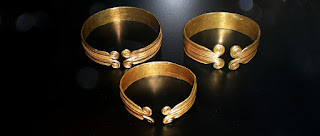Denisovan Zana?
In the 1850´s was in Ochamchir
region of Abkhazia in Caucasus, Russia, captured a wild women, who was
named Zana. Zana was 2 m tall, covered with thick dark (or red) hair and has enourmos
power, she would outrun a horse, swim across the Moskva river even when it
rose in violent high tide or effortlessly climb trees. Zana had thick arms,
legs, fingers and massive bossom. She had also bold lips and oblate nose,
per witnessess she looks like half-human, half-ape. For first years she was
kept in the cage, where she dug a hole for herself. After some time she
was helping with smaller works. Even in the worst frost she swam in the stream
and was not sick. She had 6 children, but most of them died and only 2 of them,
son Chvit and daughter Gamasa, survived.
People from remote location still
reports observation of wild people. Even before few centuries it was normal to
meet these people. According to some theories these people could be surviving
Neanderthals, who evolved simultaneously with us in different parts of the
world. For example as stated Aleš Česal „in
Slavic ethnic group remain a set of rumors about the members of wild nation – wild men and women, who lived in the forests and mountains.“ More
detailed description of the wild women brough us Otomar Dvořák, who states that
„these women were particularly repulsive
appearance, naked or partially wrapped by some animal skin, whole their body
were covered with sparse red hair and luxuriant mane of red hair.“ With
wild people apparently had some people trade and wild women gave for bread „otherwise difficultly obtainable forest
herbs and medicinal roots.“ Wild women had also good healing abilities.
Similar stories about wild people come also from the Caucasus or Normandy. We
can thus assume that Zana was this type of wild women. As witnessess told that
Zana wasn´t ill, we can assume that she also know forest herb and medicinal
roots.
From Caucasus are known large,
ape like creatures, called Almas what is Mongolian for „wild man.“ These hairy
humans usually dwells in mountains and are active at night. As mentioned
professor Boris Porshnev thier teeths are like a mans, but larger. In 1937
one expedition shooted two Almas. They were about the size of man and covered
with red hair. Porshnev thought that these creature are last surviving group of
Neanderthal men.
One theory is saying that also
Zana was a member of the remnants of a Neanderthal race in this area,
but, althought per DNA tests Zana was from Africa, they also showed that Zana
was not Neanderthal. So what she could be? Professor Sykes has theory, that
Zana could be a remnant of an earlier human migration out of Africa, but
what specie it could be?
Per my theory Zana can be
Denisovan. Denisovan is extinct specie, or subspecie, of archaic human in the
genus Homo. The name is derived from place of finding remains of this specie in
Denisova Cave in the Altai Mountains in Siberia. This cave was inhabitet also
by Neanderthals and modern humans, but after examining the bone of little
finger was showed to be genetically distinct from these.
Denisovan shared a common
origin with Neanderthal. Out ancestors homo sapiens crippled with them and have
offspring. It has brough the ability of Tibetans to revitalize their lives in
great heights. Inuits have inherited variants of genes that increase their
resistance to extreme frost. As we already stated Zana was catched in the
mountain and she did not have any issue to swim in cold water and also she refused
to wear clothes, that is, she could withstand frost. Thus it looks more than possible that Zana was a Denisovan.



Comments
Post a Comment
Have you heard about that? / Do you have some personal story about that?